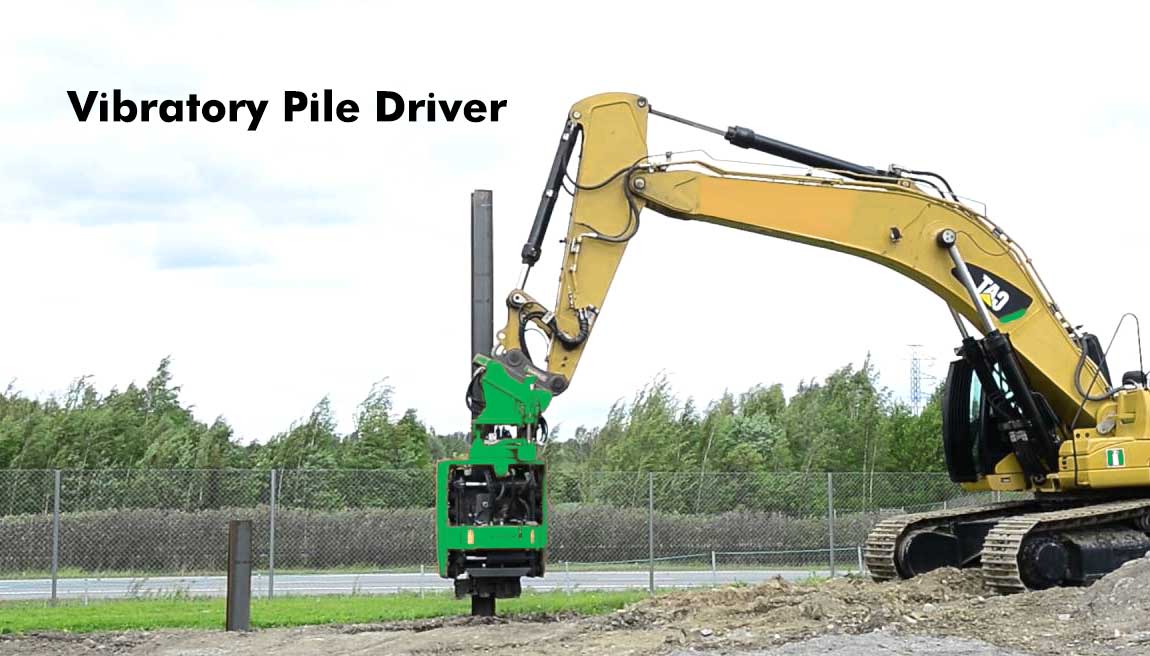Vibratory Pile Driver and Extractor Systems
- pileadmin
- Jan, 01, 2020
- Uncategorized
- Comments Off on Vibratory Pile Driver and Extractor Systems

Vibratory pile drivers push piles for the construction of foundations for bridges, roads, and docks. Unlike traditional pile drivers, vibratory pile drivers are small and quiet during operation. Vibratory pile drivers mounted with extractors drives and extract piles in and out of the ground.
Vibratory pile drivers are efficient and quick to drive files into the soil. They are small and easy to transport from one place. It is suitable for piling areas with low noise tolerance.
The vibratory pile driver uses spinning counterweights to create a vibratory motion to the pile. The vibratory motion drives the piles into the ground. Unlike a traditional pile driver, a vibratory pile driver makes the pile slip into the ground. It makes the pile move faster with less effort. Depending on the condition of the soil, a vibratory pile driver pushes a 30m long pile less than 10 minutes. A traditional pile drivers that use large weights usually take an hour to drive the pile of the same length.
1. Types of the vibratory pile driver
There are two types of vibratory pile drivers based on the suspension of the hammer, free handing and lead system. A free-hanging system has the vibrator controlled by a mobile crane. A power unit transmits energy and hydraulic to the vibrator. A leaded system has a telephonic leader that guides the vibrator. It is mounted on an adapted excavator machine that supplies power.
Free hanging systems are flexible, cheap and able to reach large locations. The vibratory hammers of a free-hanging system are of two types, electric and hydraulic. Both these hammers have many common traits but differ in their working principle. An electric hammer uses an electric motor to power it. A hydraulic hammer use hydraulic motors to power and spin the counterweights.
Pile Vibrators Extractors, PVE or Vibratory hammers with hydraulic excavator drive and extract steel sheet piles. It is simple and easy to operate and caters for environments with space restrictions, riverbanks, and marshlands. It has powerful functions for piling and easy to move from place to place.
2. Purpose of a vibratory pile driver.
Vibratory pile drivers are best suitable for underground land with clay or weak soil. Such soils have huge groundwork costs and delays for potential developers. The vibratory pile technology provides cost-effective and ground improvements for such weak soils. It improves the load-bearing capacity and adequate structure for laying the foundation on these soils.
They are also used for soil densifying and vertical drainage. It can drive casings for gas and oil pipes at a depth of a hundred meters.
The main purpose of using vibratory pile driving includes
a. Effective improvement of the load-bearing capacity of weak soils up to a depth of 20 meters.
b. Customized treatment methods that are suitable for local soil conditions.
c. Cost-effective and faster than traditional pile driving.
d. Minimizes partial and local liquefaction of soil due to seismic activities.
e. Produces low noise and vibration.
f. High productivity that is suitable for a large number of pilings.
g. Adjusts tolerance of piles and realign the pile after its service period.
h. No limit on hammer diameter, as pieces of the hammer, can be joined together to form a bigger hammer.
3. Where Vibratory pile drivers are not suitable?
Vibratory pile drivers are not suitable on soils that have more than 12% silt or 2% clay. They are not beneficial where you need more control and reliable load-bearing capacity of the pile.
4. Features of a vibratory pile driver.
A vibratory pile driver consists of a power pack and a vibratory hammer. The power pack is driven by the diesel engine to supply oil to the vibrator hydraulic pump.
The vibratory hammers are powered by either an electric or hydraulic motors. Hydraulic hammers more powerful and weighs half the weight electrical hammer. They spin faster and are most suited for foundations next to old buildings or soils that get loose on vibration.
A Vibratory hammer consists of a vibration case, a suppressor and a clamp.
a. Vibratory case.
A vibratory case has many pairs of eccentric weights. These weights rotate in a vertical plane to create the vibration. It creates a vertical vibration of constant frequency that drives the piles.
b. Suppressor
Vibration suppressor assembly is placed on the vibration case to suppressor vibration. It consists of rubber elements to suppress the vibrations during the piling.
c.Clamp.
Clamps are used to grip the piles while driving it or extracting it. It contains two gripping jaws, with one fixed and the other movable. The cylinders in the clamp’s body control the movable jaw to grip or release the pile.